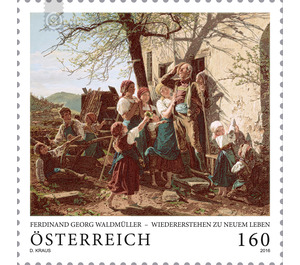Old Masters - Austria / II. Republic of Austria 2016 - 160 Euro Cent
Theme: Art & Culture
| Country | Austria / II. Republic of Austria |
| Issue Date | 2016 |
| Face Value | 160.00 |
| Edition Issued | 180,000 |
| Printing Type | Offset stitch (Etch-Art by OeSD) |
| Stamp Type | Commemorative |
| Item Type | Stamp |
| Chronological Issue Number | 2615 |
| Chronological Chapter | OOS-OE2 |
| SID | 900236 |
| In 67 Wishlists | |
The great Austrian Biedermeier painter Ferdinand Georg Waldmüller, born in Vienna in 1793, already attended the Academy of Fine Arts at the age of 14 and initially earned his living as a drawing teacher, portrait and scenery painter. Over time, he also began to paint landscapes and those genre scenes with everyday scenes, for which he later became so famous. He traveled again and again to Italy and the Salzkammergut, where many of his most famous works were written. In 1829 he was employed at the Academy as a curator for the collection of paintings and as a teacher, but his relationship with his employer soon clouded over, as Waldmüller's ideas for reforming teaching and the academic collection were always rejected. He was no longer allowed to give private lessons in the Academy premises and soon lost his studio there. Rather, Waldmüller found artistic recognition abroad when he sold some pictures at the World's Fair in Paris and during a visit to London's Buckingham Palace. It was only long after his death that his works were rediscovered and their significance recognized. The oil painting "Rebirth to new life" was created in 1852 and today belongs to the valuable stock of the Princely Collections of Liechtenstein. Light and shadow are the elements that breathe life into the scene. This is reflected not only in the smiling faces of the people, but also in the all-round blossoming nature - in the green branches of the tree or in the flower bouquet in the girl's hand. Despite their obvious poverty, people are enjoying the recovery of the old farmer and the bright spring day. With immense detail Waldmüller characterizes the individual persons in the picture; the clothes, the tree, the building - everything is depicted with the utmost meticulousness.


